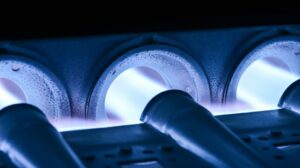Natural gas furnaces are found in more homes around the country than any other type of heating system. That alone should tell you that these heaters are generally safe to use for winter warmth.
However, combusting any type of fuel can pose dangers, and gas furnaces do have the potential to create hazards such as leaking of toxic carbon monoxide gas and larger combustion explosions. The best way for you to ensure that your home’s gas furnace runs at its safest is to schedule an annual professional furnace inspection and tune-up and to always move quickly when you need furnace repair in Bergen County, NJ by calling the BD Heating & Cooling team. We offer 24/7 emergency service for good reasons!
If you’re curious to know more about how gas furnaces maintain high levels of safety, follow along as we look at several of their important safety features.
Flame sensor
One danger gas furnaces can potentially pose is allowing for a build-up of unburned gas inside the combustion chamber. If the furnace is flooded with this gas because of an ignition failure, a single spark will cause an explosion that can damage the rest of the furnace and may escape to the exterior. To prevent this, a furnace has a flame sensor that detects whether the burners have ignited after gas starts to flow to them. If the burners fail to ignite, the sensor shuts off the gas flow so the combustion chamber isn’t flooded with unburned gas.
Flame roll-out switch
Flame roll-out is when flames escape from the combustion chamber and leap to other parts of the furnace or the area around it. This can occur if there’s insufficient oxygen for combustion and the flames jump to the nearest oxygen source—outside of the combustion chamber. The flame roll-out switch detects if the flames aren’t being drawn into the heat exchanger and immediately shuts off the gas to stop flame roll-out.
Draft inducer
Carbon monoxide and other hazardous byproducts of combustion are supposed to exit the furnace through a flue, safely escaping from the house. The draft inducer registers that air pressure is moving these gases up the flue. If the air pressure changes so that combustion gases may be pushed backwards into the furnace and the house, the draft inducer will shut off the furnace.
Limit switch
This is a heat detection device attached to the plenum of the furnace that monitors the temperature of the heat exchanger. During a normal heating cycle, the heat exchanger gradually cools down as air moves around it and draws away heat. If something goes wrong that causes the heat exchanger to either not cool down or continue to heat up, the limit switch will shut off the burners while continuing to allow the air to move around the exchanger to cool it down.
Remember, the best way to ensure that these safety devices are working properly is to have your furnace given a fall inspection. Our technicians will check all safety precautions as well as examine the furnace for heat exchanger cracks and gas line troubles.
DB Heating & Cooling, Inc serves the heating and cooling needs of customers throughout Rockland County, NY as well as Bergen County, NJ and surrounding communities. You can count on us for expert services. Contact us today!

